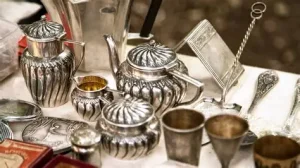The first step into Negozio Antiquariato Roma feels like crossing into another lifetime. The air carries the quiet hum of forgotten stories waiting to be heard again. Every corner holds fragments of history wrapped in dust and wonder. It’s a place where time refuses to fade and memories find a second home.

What makes antique shops so enchanting is the way they blend mystery and meaning. Each object seems to guard a secret, whispering of lives once lived and dreams once pursued. People don’t just buy items there—they adopt pieces of other people’s journeys. This exchange between past and present creates a connection that modern things rarely inspire.
Antique shops attract those who crave authenticity in a world obsessed with speed and trends. They offer a slower rhythm where beauty is measured by imperfection and endurance. A chipped vase, a faded painting, or an old clock becomes a symbol of resilience. These imperfections tell stories that perfection could never hold.
Collectors often describe antique shopping as a form of meditation. Searching through shelves and drawers becomes an act of discovery and patience. The thrill doesn’t lie in possession but in recognition—the instant you feel an unseen bond with an object. That connection turns a simple purchase into a timeless encounter.
The most interesting part of antique culture is how it bridges generations. Younger collectors often find meaning in pieces once owned by their grandparents’ era. They see these objects not as old, but as enduring symbols of creativity and craftsmanship. This shared appreciation becomes a quiet conversation between past and present.
Reviews and reflections from antique enthusiasts often mention the emotional pull of nostalgia. It’s not about longing for what’s gone but about understanding where we came from. Each artifact becomes a mirror reflecting evolution—of design, taste, and human imagination. The shop becomes both museum and sanctuary.
In recent years, antique shops have taken on new roles beyond mere commerce. Many now serve as cultural storytellers, preserving craftsmanship that technology can’t replicate. Visitors come not only to buy but to learn the origins of styles, symbols, and traditions. These spaces keep history alive in tangible form.
What’s fascinating about antique collecting today is the merging of old and digital worlds. Modern enthusiasts use technology to trace the origins of their finds. Yet, even with such tools, the charm of physical exploration remains unmatched. The act of discovery—touching, observing, and feeling—cannot be replicated on a screen.
Many antique shop owners describe their work as custodianship rather than trade. They see themselves as caretakers of objects with souls. Every restored frame or polished handle feels like breathing life into something once lost. That care creates an emotional bridge between the craftsman of the past and the admirer of today.
A new trend emerging among visitors is emotional collecting. Instead of buying for value, people buy for resonance. They look for pieces that echo something within—a memory, a feeling, a story. This form of collecting turns antique shopping into a deeply personal journey.
The evolution of antique shops also reflects shifting ideas about sustainability. As society grows more conscious of waste, antiques symbolize meaningful reuse. They remind us that beauty doesn’t need to be newly made to be valuable. Preserving the old becomes an act of ecological and emotional care.
Walking through an antique shop feels like navigating an archive of artistry. Each shelf carries a mixture of invention and memory, shaped by hands long gone. The texture of wood, the fading of color, the weight of metal—all tell different stories. It’s a quiet museum without glass barriers or distance.
The people drawn to antique shops are often storytellers at heart. They see narrative potential in every relic. A rusted key may unlock imagination more than any modern object could. These places attract those who seek meaning, not just material.
In many ways, antique shops have become havens for reflection. The slow pace of browsing contrasts the digital rush of everyday life. People rediscover mindfulness in the act of holding an object with history. The silence between shelves becomes a gentle meditation on time and purpose.
A fascinating discussion among collectors today revolves around emotional inheritance. Some believe that objects carry traces of their owners’ energy. This belief adds an almost spiritual dimension to antique collecting. It’s as if touching an old artifact connects you to unseen fragments of humanity.
The craft behind many antiques often leaves visitors in awe. The precision of hand-carved wood or the softness of handwoven fabric reminds us of lost patience. Before mass production, beauty took time—and it showed. Antique shops preserve that patience as a silent lesson for modern makers.
Another new insight about antique shopping is its therapeutic nature. Many visitors describe finding comfort in the permanence of these items. While everything else changes rapidly, these pieces remain steadfast. Their endurance offers reassurance amid chaos.
For some, the antique shop becomes a place of memory reconstruction. They find objects similar to those once owned by loved ones, reviving connections that time erased. Holding something familiar rekindles emotions long buried. It becomes a reunion between memory and touch.
There’s also a philosophical layer hidden in antique exploration. It teaches people to see worth in what has aged, faded, or cracked. In doing so, it challenges modern culture’s obsession with the new. The appreciation of age becomes an act of rebellion against disposability.
Reviews from modern collectors often mention how antique shops shape creativity. Artists and designers visit them to draw inspiration from history’s aesthetics. Patterns, textures, and materials influence new works in subtle ways. The past becomes a springboard for future innovation.
Interestingly, antique trading has also become a means of storytelling through curation. Each shop represents the owner’s eye for history, taste, and sentiment. The way items are displayed tells a silent story about cultural appreciation. The shop itself becomes a work of living art.
In some cases, antique shops become meeting places for like-minded souls. Conversations flow naturally as people share what they’ve found or hope to find. These exchanges turn commerce into community. The shared admiration for heritage forms friendships across generations.
The growing fascination with antiques also challenges perceptions of value. Price alone no longer defines worth; meaning does. A simple letter opener may hold more significance than a jewel-encrusted trinket. What matters is the story it carries and the emotion it evokes.
The scent of old pages, the creak of aged furniture, the gleam of brass under soft light—these sensory details define the charm. Antique shops remind people that beauty engages all senses, not just the eyes. Every detail contributes to the immersive experience of time travel. This sensory richness is part of what keeps visitors returning.
New generations have begun to reinterpret the role of antiques in modern living. Instead of viewing them as relics, they integrate them into contemporary design. The result is a fusion of eras that feels both timeless and personal. This blend of old and new redefines aesthetic balance.
Some reviews discuss how antique shopping teaches patience and gratitude. It’s not about instant gratification but about discovering the right piece at the right time. This delayed satisfaction mirrors the rhythm of craftsmanship itself. It’s a reminder that meaning often takes time to emerge.
Many collectors find that antique shops encourage deeper appreciation for history beyond textbooks. Every item offers a tangible lesson in innovation and evolution. Through design, one can trace changes in society’s values, priorities, and technologies. This educational aspect transforms curiosity into awareness.
Another modern development is the rise of ethical restoration. Instead of over-polishing or altering items, restorers now aim to preserve authenticity. The idea is to maintain character, not erase age. This respectful approach keeps the spirit of the piece intact.
People often describe their first antique purchase as a milestone. It marks the beginning of a relationship with time itself. From that moment, they start seeing the world differently—through textures, stories, and craftsmanship. It becomes more than collecting; it becomes communion.
Even those who don’t buy often leave with something intangible. They carry the quiet peace of having touched time and memory. Antique shops remind people that existence is cyclical, that creation and decay coexist beautifully. Every object once new will one day tell its own story.
The evolving perception of antique culture reveals a deeper human longing for permanence. In a world defined by constant change, holding onto something enduring feels sacred. Antique shops answer that need by offering continuity through objects. They remind us that progress doesn’t have to erase the past.
A modern interpretation sees antique collecting as a dialogue with craftsmanship. Each piece reflects the discipline and artistry of human hands. This recognition fuels respect for manual creation in an age ruled by automation. It reawakens our admiration for patience and detail.
As sustainability gains importance, antiques represent the most elegant form of recycling. Each purchase prevents another item from being discarded or forgotten. It transforms consumption into conservation. This makes antique shopping both ethical and emotionally fulfilling.
In essence, antique shops serve as quiet storytellers of human resilience. They gather fragments of lives once vibrant and give them new meaning. Each visit becomes a reminder that beauty survives even through loss and time. The old continues to inspire, not because it resists change, but because it carries proof of having lived.
In the end, an antique shop is not just a store—it’s a conversation between generations. It’s where history breathes again through hands willing to listen. As long as people seek meaning beyond novelty, these places will thrive. For within every antique lies a gentle truth: time may pass, but its echoes never fade.
